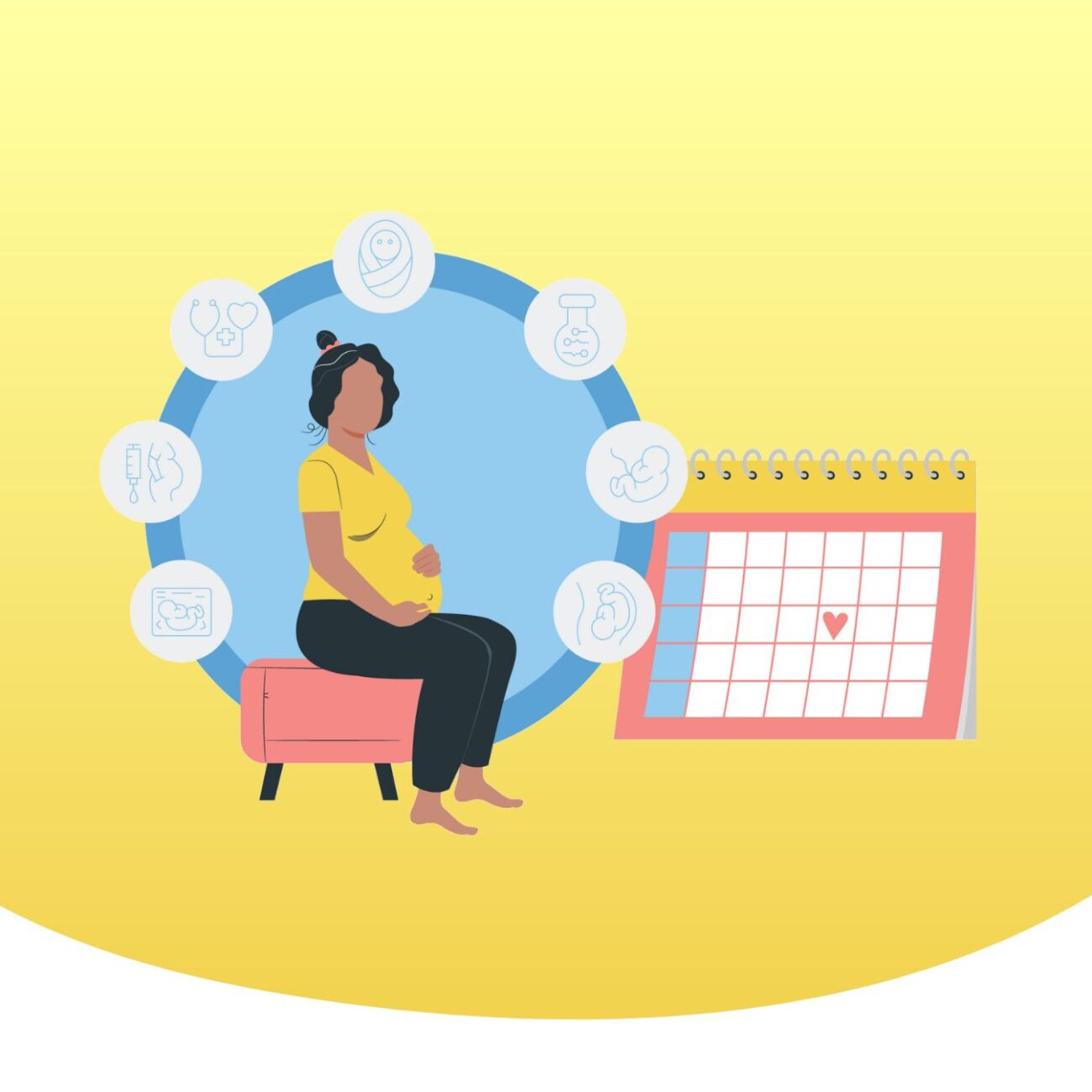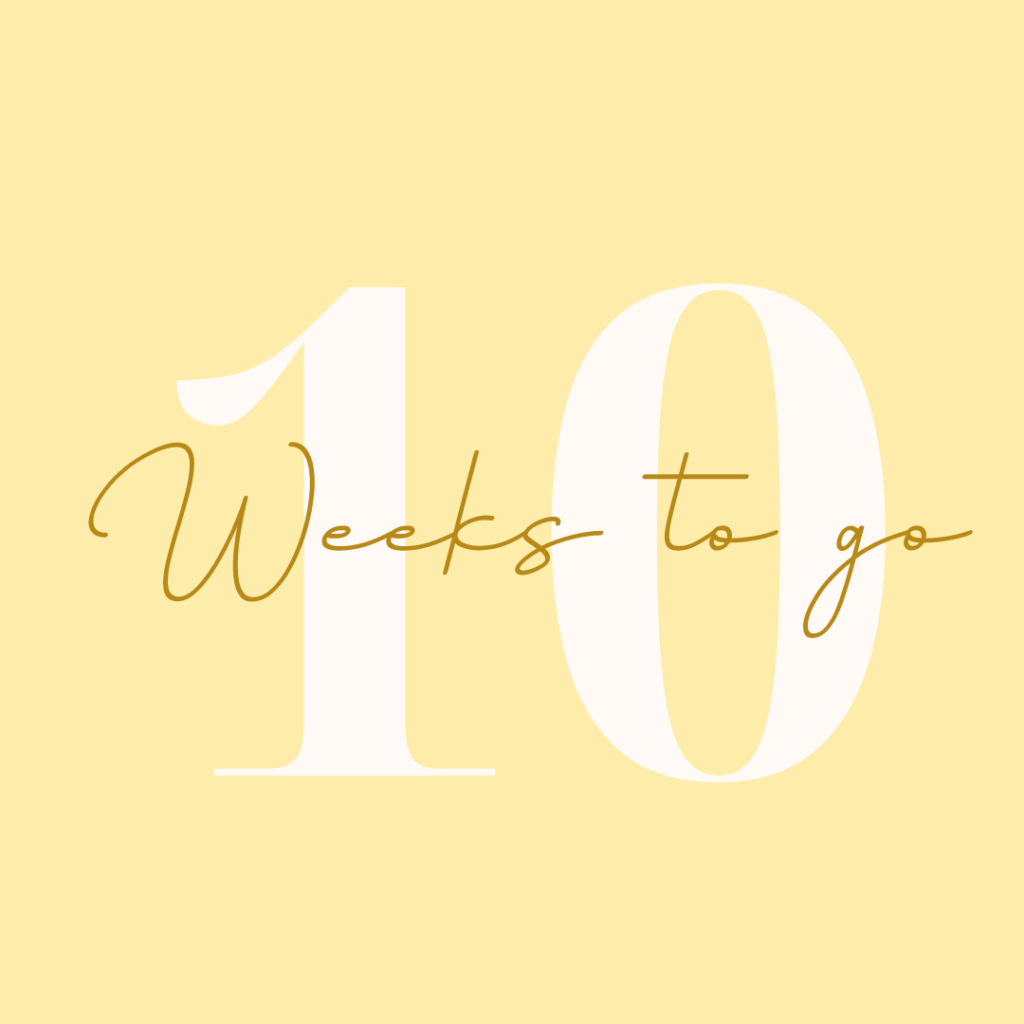
PREGNANCY WEEK BY WEEK
Early Signs Of Pregnancy
In all pregnancy stages, knowing what to expect will help you know how to handle each stage and deal with pregnancy side effects and changes taking place in your body.
If a woman isn’t aware of her pregnancy, early signs of pregnancy may appear similar to routine premenstrual discomforts.
The most common early signs and symptoms of pregnancy might include:
- Missed menstrual periods
- Breasts soreness /tenderness
- Extreme fatigue
- Nausea
- Cramping / slight bleeding
- Heartburn
- Cravings
- Sensitivity to smells
- Mood swings
- Headaches
- Constipation
- Frequent urination
The woman can start experiencing some of the early signs of pregnancy within days after conception.
Now, let’s see what happens in every stage of pregnancy.

Week 1
During the first week of pregnancy, the egg moves from the ovary and travels through the fallopian tube. So, the baby does not show any significant growth in the first week. In the first week, the doctor calculates the first day of the last monthly menstrual cycle and it is from this day that the nine month or 40 weeks pregnancy term is calculated.

Week 2
One of the early signs to notice is that urination will be frequently. This may happen from time to time depending on the body.

Week 3
Feeling nauseated can begin at week 3 as the HCG hormone starts getting released into the newly pregnant body. At week 3, what people call morning sickness is a full-day sickness.

Week 4
4 weeks of pregnancy may seem like nothing is going on and it may begin to wonder whether if one is pregnant?? The blastocyst has concluded its journey from the fallopian tube to the uterus.

Week 5
Now that one is 5 weeks pregnant, one of the things that will be going on in the body is the continual development of the placenta. The pregnancy hormones in the body would have fully taken their place. These pregnancy hormones are the chemical signals that will pass the information all over the body and make the necessary changes that the body needs.

Week 6
By the time of 6 weeks pregnant, all the hormones in the body would have taken their full place for the changes to take place. At this time, the feelings of an early pregnancy symptoms like the morning sickness or nausea and so on would be fully felt. By implication, there is a full assurance that one is pregnant. In fact, every test carried out will end up positive.

Week 7
By the time of 6 weeks pregnant, all the hormones in the body would have taken their full place for the changes to take place. At this time, the feelings of an early pregnancy symptoms like the morning sickness or nausea and so on would be fully felt. By implication, there is a full assurance that one is pregnant. In fact, every test carried out will end up positive.

Week 8
The uterus is growing as the baby grows. The breasts will be growing more sensitive as they begin to prepare for lactation. Varicose veins, dark veins that develop around the breasts due to the increase in blood supply may appear. These veins do not appear on all women, but most experience them.

Week 9
The uterus is still growing, and should be close to the size of a cantaloupe at nine weeks pregnant. One probably feels extra bloated and maybe a bit lethargic, but this is mainly due to the hormones that are floating around in the body system.

Week 10
One gain weight up to one to three pounds, yet you feel like you’ve gained much more. The bloated feeling hasn’t gone away yet, but as one reaches the end of the first trimester, other pregnancy symptoms such as morning sickness are subsiding.

Week 11
In the eleventh week, gaining weight, breasts becoming larger and tender, and the abdomen may appear distended. The abdominal distention is mostly due to increased bowel contents caused by the slowing down of the intestines due to the increased production of progesterone.

Week 12
The uterus is now protruding above the pubic bone, and through weeks 12–16 one starts showing the baby bump.

Week 13
At week 13, the pressure on the bladder begins to subside as the uterus grows up and out of the pelvic bones. As the waistline thickens and the pressure is relieved from the bladder, one may begin to experience abdominal pains.

Week 14
The appetite will increase and one will feel the need to “eat for two.” The spots and freckles will continue to darken and the breasts will continue to be sensitive, possibly growing in size as one is getting prepared for lactation.

Week 15
It is quite natural if one has gained a little more or a little less than that. The toughest situation moms-to-be face during this week is that the ligaments that support the uterus are continuing to grow, causing sharp pain in the abdomen.

Week 16
The biggest change in the body at 16th weeks is the look and size of the breasts. Milk glands start production and veins become more visible as the blood flow increases. An increased weight in the womb as the waistline continues to stretch and expand. Pregnancy back pains are also due to begin, as most women gain five to ten pounds at this point.

Week 17
At 17 weeks abdomen grows as the internal organs move around, providing space for the uterus and baby. The uterus begins pushing the intestines up and outwards, towards the sides of the abdomen, allowing to feel the uterus more when one is standing rather than sleeping or lying down.

Week 18
The waistline is probably expanding greatly during this week. If taken two fingers and place them just below the belly, one can feel the uterus. It’s still the size of a cantaloupe, and at this point one is starting to show.

Week 19
Commencement of the week 19 observes more changes on the exterior of the body. Dry, flaky skin may form as the metabolism and blood volume increase. Tendency to dehydrate and sensitivity to heat will increase.

Week 20
Commencement of the week 19 observes more changes on the exterior of the body. Dry, flaky skin may form as the metabolism and blood volume increase. Tendency to dehydrate and sensitivity to heat will increase.

Week 21
Continuous gaining up to a pound of fat each week is seen in week 21. Uterus moves a ½ inch above the belly button, the abdomen pooches out. One may begin to experience leg cramps and aches. Sometimes one may faint, so it is important you wear loose, comfortable clothes.

Week 22
The most noticeable change in this twenty-second week is going to be weight gain. As the baby grows and the waistline expands, one can expect to gain close to a pound per week.

Week 23
At the 23rd week, baby will start kicking, hitting, or punching more often. As the stomach muscles continue to stretch, the uterus rises about 1 ½ inches above the belly button. Depending on what the weight was last week, one may have gained up to a pound by now.

Week 24
At 24 weeks some women begin to experience what is known as Braxton Hicks contractions. These are due to the tightening of the uterus that happens from time to time. One is probably showing quite a bit more, as the uterus has risen to about two inches above the belly button.

Week 25
As the baby’s hair grows, one will probably notice own hair growing more quickly too. Skin may be dry and itchy from all the stretching, one may also notice that the eyes are dry, and they may be sensitive to light.

Week 26
Experiencing more frequent Braxton Hicks contractions, which feel like menstrual cramps, and one will frequently feel the need to use the restroom and the need to lie down. Many women begin to experience pain under their ribs as the baby kicks and stretches inside the uterus.

Week 27
At 27 weeks, one may be fighting for food cravings. As the uterus continues to grow and put pressure on the upper chest area, one may be experiencing chest pains or shortness of breath. Also experiencing swelling in the face, neck, hands, feet, ankles, legs, are noticed.

Week 28
As the uterus applies pressure to the colon, constipation becomes more frequent. Other symptoms such as fatigue, leg cramps, pregnancy pains, frequent urination, haemorrhoids, and insomnia continue to plague day-to-day life. Most women also begin to experience Braxton Hicks contractions at this point; this is a false sign of labor.

Week 29
As the hormones continues to fluctuate, one will experience skin rashes, dryness, and intense itching at week 29. Experiencing mood swings, feeling fatigue are due to the amount of weight gaining. Varicose veins may begin to form on the legs, and this too is normal.

Week 30
Pregnant women gain the most weight during weeks 20 – 30. As this thirtieth week comes and goes, one will continue to gain weight, but the most dramatic physical changes are pretty much over. One may be feeling uncomfortable due gaining weight and as pregnancy pains continue to plague the daily life. Pregnancy hormones will loosen up the joints and the amount of amniotic fluid will decrease as the baby grows inside.

Week 31
This thirty-first week of pregnancy signifies that birth is near, but it may feel like it’s not near enough! As the round ligament pain decreases, one may begin to experience back pain like never before. Sleeping comfortably for long periods is impossible for most expectant mothers.

Week 32
This thirty-first week of pregnancy signifies that birth is near, but it may feel like it’s not near enough! As the round ligament pain decreases, one may begin to experience back pain like never before. Sleeping comfortably for long periods is impossible for most expectant mothers.

Week 33
By the thirty-third week the belly should be close to the size of a basketball. The waistline is still growing as one gain up to one pound per week. Insomnia is very common at this point. Back pain, leg pain, and foot pain are likely ever-present. Gaining of the weight remains constant at this week.

Week 34
The biggest thing one will notice in this thirty-fourth week is the reduction of pressure on the chest and lungs. This is due to the baby moving down into the pelvis area. The uterus should be close to 5 ½ inches above the belly button. The belly button is probably extremely sensitive too. Some women have heartburn due to relaxation of the muscles in the lower oesophagus. Swelling in the hands, wrists, face, legs, ankles, and feet is likely increasing.

Week 35
One should have gained 25–29 pounds by this thirty-fifth week. The uterus is about six inches above the belly button, and the belly button may be sensitive to the touch. The baby should be moving to a head-down position in the pelvis region, which reduces pressure on the ribs, chest, and lungs, but increases pressure on the bladder.

Week 36
Most women feel like they are “done being pregnant” by the thirty-sixth week. One probably still suffers from fatigue, constipation, insomnia, pregnancy pains, restlessness, haemorrhoids, and everything else. Pressure in the lower abdominal area is referred to as lightening or engagement. Some women find that walking is incredibly difficult, while others have adapted to their pregnant bodies.

Week 37
As the 37th week of pregnancy comes and goes, one may be experiencing more and more pressure on the pelvic bones if the baby uses them as a pillow. As the weight increases, one may also be feeling the effects of gravity. Exhaustion is expected. As the waistline has been expanding, so the breasts. They are full of milk, ready for feeding, and beginning to secrete colostrum. Leakage from the breast is a common occurrence.

Week 38
Increased mucus discharge at this stage is normal as the cervix softens and prepares for labor. As the baby moves into the birth canal many women will also experience increased pelvic pressure and back pain. Swelling in the body, especially the feet, is quite apparent at this point, especially in warmer, more humid areas, as increased humidity draws fluid into the tissue.

Week 39
One likely experience discomforts every moment as the 39th week comes and goes. One may be experiencing difficulty getting up from a sitting or lying position. The breasts will continue to grow and become increasingly sensitive. One may even begin leaking a fluid called colostrum. Every part of the body is beginning to swell.

Week 40
Pains are increasing due to pressure caused by the amount of weight gained, as well as the movements of the baby. There is now very little room for the baby to move around, so it may feel like the baby is not moving as much. There is much more pressure being placed on the bladder, groin, and lower abdomen.
